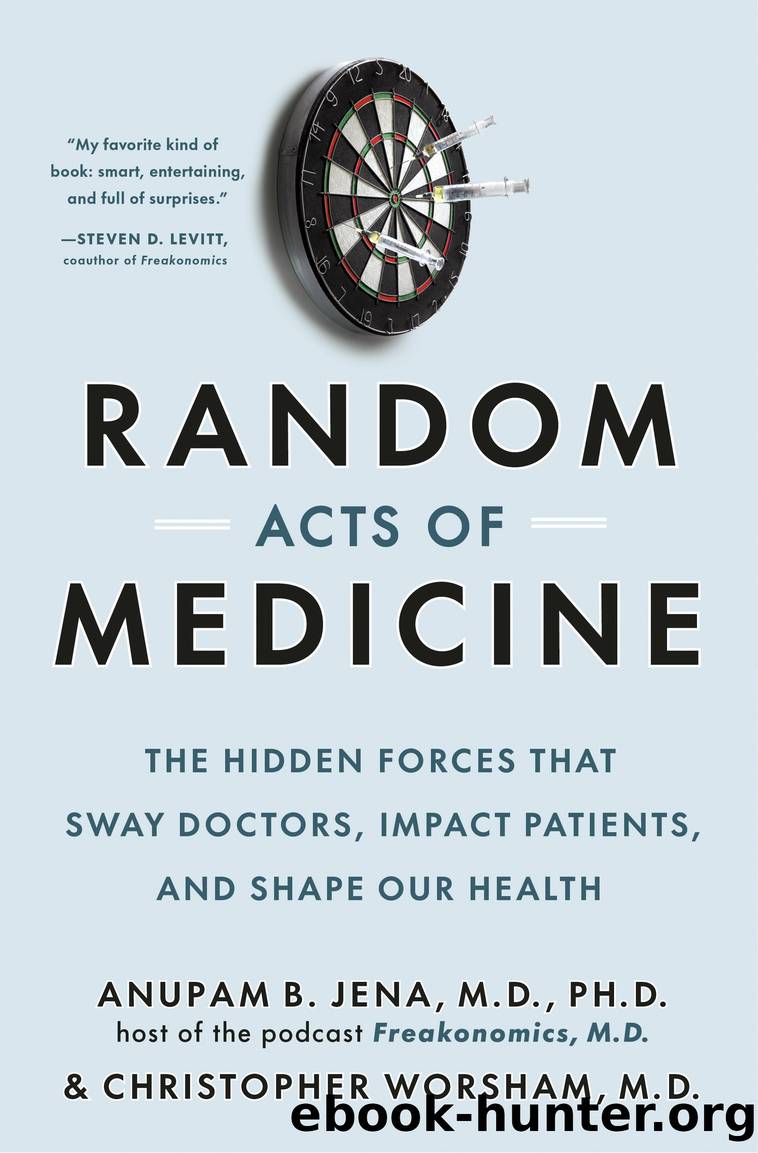Random Acts of Medicine: The Hidden Forces That Sway Doctors, Impact Patients, and Shape Our Health by Anupam B. Jena & Christopher Worsham

Author:Anupam B. Jena & Christopher Worsham [Jena, Anupam B. & Worsham, Christopher]
Language: eng
Format: epub
Publisher: Knopf Doubleday Publishing Group
Published: 2023-07-11T00:00:00+00:00
In general, as adolescents got older, there was a gradual increase in the probability of being prescribed an opioidâperhaps not surprising under the assumption that doctors would find opioids less risky to prescribe to an older adolescent. But there was a jumpâa discontinuityâat age eighteen, the cutoff between âchildâ and âadult.â Patients aged seventeen years and eleven months received an opioid 13.7 percent of the time, while those aged eighteen years and one month received an opioid 15.3 percent of the timeâa 1.6-percentage-point increase. Under a statistical model[*6] that accounted for the gradual increase in prescription rates as well as confounding factors, we estimated this to be closer to a 1.3-percentage-point increase.
In other words, this meant that for adolescents around age eighteen, being labeled an âadultâ made them 9.7 percent more likely to receive an opioid than if they had been labeled a âchild.â With an estimated 20.2 million ED visits by patients aged fifteen to twenty-four annually in the United States, this difference corresponded to at least tens of thousands of arbitrary opioid prescriptions filled each year.
Opioid pain medications are dangerous, as we all know by now, placing patients at risk of long-term use, addiction, and overdose.[*7] Of course, doctors prescribe them to treat pain when the benefits of pain control are felt to outweigh the risks of the medication. But when such drug prescriptions are influenced by arbitrary factorsâin this case, an adolescentâs proximity to adulthoodâthereâs only risk, no benefit. And if indeed opioids were being prescribed with this arbitrary influence, we should see an increase in adverse events associated with them, right?
We looked at the same group of adolescents, but this time focused on the probability that any one of several major opioid-related adverse events occurred after an ED visit: new long-term opioid use, a new diagnosis of opioid use disorder, or overdose. Fortunately, these events are uncommon following ED visits. We found that in only 1.6 percent of all ED visits did one of these events occur in the year following the visit. But using a statistical model similar to the one used before, we found that being considered an âadultâ rather than a âchild,â regardless of their true age, was associated with a 0.2-percentage-point increase in the rate of an adverse event, making patients around age eighteen who happened to have been labeled âadultsâ 12.6 percent more likely to have an adverse event than those labeled a âchild.â
Our results showed us a few important things. As noted, adolescents around eighteen were being treated differently in the ED depending on whether they were labeled a âchildâ or an âadult,â resulting in differing rates of opioid prescriptions and subsequent adverse events. We canât say for sure what was driving the difference, but we believe it was some combination of representativeness bias on the part of physicians (treating âchildrenâ one way and âadultsâ another) coupled with differences in treatment protocols (when patients go through âpediatricâ care systems versus âadultâ care systems).
As we continue to grapple with the opioid epidemic, such results can be demoralizing.
Download
This site does not store any files on its server. We only index and link to content provided by other sites. Please contact the content providers to delete copyright contents if any and email us, we'll remove relevant links or contents immediately.
| ASVAB | GED |
| GRE | NCLEX |
| PRAXIS | SAT |
| See more | Flash Cards |
| Study Guides | Study Skills |
| Workbooks |
Talking to Strangers by Malcolm Gladwell(13222)
The Compound Effect by Darren Hardy(8808)
Tools of Titans by Timothy Ferriss(8216)
Wonder by R. J. Palacio(8007)
The Lover by Duras Marguerite(7830)
A Court of Wings and Ruin by Sarah J. Maas(7650)
The Circle by Dave Eggers(7035)
Deep Work by Cal Newport(6879)
Kaplan MCAT General Chemistry Review by Kaplan(6866)
To All the Boys I've Loved Before by Jenny Han(5774)
Wiseguy by Nicholas Pileggi(5671)
The Body: A Guide for Occupants by Bill Bryson(4974)
1,001 ASVAB Practice Questions For Dummies by Powers Rod(4453)
Eat That Frog! by Brian Tracy(4434)
Cracking the GRE Premium Edition with 6 Practice Tests, 2015 (Graduate School Test Preparation) by Princeton Review(4224)
Pre-Suasion: A Revolutionary Way to Influence and Persuade by Robert Cialdini(4145)
Barron's AP Biology by Goldberg M.S. Deborah T(4096)
ACT Math For Dummies by Zegarelli Mark(3994)
Alive: The Story of the Andes Survivors by Piers Paul Read(3968)
